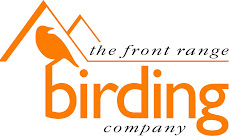A small group of us (including fifth grader, Reilly) had a great walk Saturday morning at Hudson Gardens (see species list below). Even though the breeding season is pretty much done, there are a number of on-going avian tales to be told. One of these has to do with "eclipse" plumage. This occurs most notably with ducks, and happens right after the breeding season, at the end of the summer, when ducks undergo a complete body molt. When male ducks acquire "eclipse" plumage they tend to become so dull looking that for a brief time they superficially resemble their female partners - this is a good "strategy" because they are flightless for a few weeks and could therefore use a little camouflage.So, look at this photo. How many species are there, and what sex are they? This is almost exactly what we were seeing on Saturday. There are four male Mallards in this picture - the ones with the yellow bills. Two are in the dull "eclipse" plumage, and two have re-acquired most of their regular breeding plumage. The duck on the far left with the mottled orange and gray bill is a female Mallard. The final, smaller duck is a male Wood Duck in "eclipse" plumage - again, look at the color of the bill.Here's a closer look at a male Wood Duck in "eclipse" plumage. Note the faint, but easily visible, white head stripes, and the bill color.So, we had quite an "eclipse" plumage seminar on Saturday.We, also, spent quite a bit of time looking at plumage in Cooper's Hawks, but I won't go into that here.Our rare bird(s) for the day were three Hooded Mergansers. If you look at your field guide, which I know you still have out because you were just looking at Mallards and Wood Ducks, you'll notice that Hooded Mergansers are not shown breeding in Colorado. This is a developing story, but for some reason, just in the past few years there has been some very rare breeding activity, and hence there are birds around in the summer, and we were fortunate enough to get to see a few. I wish we had gotten photos, because I'm not sure whether we actually had a female and two juveniles, or a female and two "eclipse" plumage males. You just have to get used to not being able to identify every bird precisely, right?I hope to see you all on a future Front Range Birding Company walk.Best regards,ChuckHudson Gardens, Arapahoe, US-CO
Aug 30, 2014 8:10 AM - 11:00 AM
Protocol: Traveling
1.4 mile(s)
Comments: Front Range Birding Company
31 species (+1 other taxa)
Canada Goose (Branta canadensis) 34
Wood Duck (Aix sponsa) 4
Mallard (Anas platyrhynchos) 23
Hooded Merganser (Lophodytes cucullatus) 3
Common Merganser (Mergus merganser) 4
Double-crested Cormorant (Phalacrocorax auritus) 1
Great Blue Heron (Ardea herodias) 1
Turkey Vulture (Cathartes aura) 1
Cooper's Hawk (Accipiter cooperii) 3
Red-tailed Hawk (Buteo jamaicensis) 1
Spotted Sandpiper (Actitis macularius) 1
Solitary Sandpiper (Tringa solitaria) 1
Ring-billed Gull (Larus delawarensis) 3
Rock Pigeon (Feral Pigeon) (Columba livia (Feral Pigeon)) 6
Eurasian Collared-Dove (Streptopelia decaocto) 4
Belted Kingfisher (Megaceryle alcyon) 1
Northern Flicker (Colaptes auratus) 3
American Kestrel (Falco sparverius) 1
Western Wood-Pewee (Contopus sordidulus) 1
Black-billed Magpie (Pica hudsonia) 1
American Crow (Corvus brachyrhynchos) 2
Barn Swallow (Hirundo rustica) 18
Black-capped Chickadee (Poecile atricapillus) 6
Red-breasted Nuthatch (Sitta canadensis) 1
House Wren (Troglodytes aedon) 1
Cedar Waxwing (Bombycilla cedrorum) 30
Yellow Warbler (Setophaga petechia) 1
Wilson's Warbler (Cardellina pusilla) 2
House Finch (Haemorhous mexicanus) 8
Lesser Goldfinch (Spinus psaltria) 4
Spinus sp. (goldfinch sp.) (Spinus sp. (goldfinch sp.)) 1
House Sparrow (Passer domesticus) 5
Hungry momma bear & her cub
1 year ago





.JPG)

.JPG)

.JPG)

.JPG)
.jpg)
.jpg)
.JPG)







